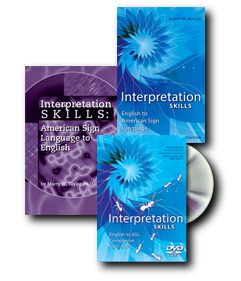The skills and experience of interpreters affect the quality of interpretations from ASL to English. Expert interpreters have more experience in the profession and tend to be more competent in both languages, English and ASL. However, both experts and novices may have some difficulty with either or both languages. Errors made may skew the message and render the interpretation ineffective.
Dr. Marty Taylor’s research in her book Interpretation Skills: ASL to English shows that effective interpretations require interpreters to have full competence in fundamental knowledge-lean skills before they can master the more complex and nuanced knowledge-rich skills.
Knowledge-lean skills are basic and fundamental language skills. In the ASL-to-English interpretation process, knowledge-lean skills are related to ASL comprehension at the lexical and discourse level. Basic knowledge of English at the lexical level is also a knowledge-lean interpretation skill. These three major features of lean skills must be present before an interpreter can move to complex interpretation tasks.
“Knowledge-rich” refers to context-sensitive interpretation skills that allow an interpreter to communicate the subtle differences in meaning and tone that the signer is expressing. Knowledge-rich skills give access to a more complex level of meaning than verbatim (word for word) interpretations. English production at the discourse level, delivery, and composure and appearance are three major features that contain knowledge-rich skills.
An analogy of knowledge-lean and knowledge-rich skills can be drawn from the field of construction. A building can not be constructed before an appropriate site is located, a plan is drawn, materials are gathered and qualified workers are available. These preparatory steps are knowledge-lean, or foundational skills. Only with such resources in place can the actual construction begin. The final product and the quality of the completed construction depend on the overall expertise – knowledge rich skills – contributed during each step of the process. For example, if the site is too small for the building planned, then the entire project will be weak and the outcome less than desirable. If, on the other hand, the site is well chosen, the architectural plan is suitable to the site (e.g., appropriate to the neighborhood in terms of appearance and size), if the materials are of good quality, and the workers are highly skilled, then the final structure will be well made.
If an interpreter’s mastery of knowledge-rich skills is not complete, errors can occur which makes the interpretation of ASL into English seem awkward or insensitive. For example, repetition of one or more signs is fairly common at the end of ASL questions, but it is unusual in English. For instance, it would be uncommon to hear the question “Who is he? Who is he?” – unless the signer had some cause to be frantic, in which case it would make sense to phrase the question twice in English. Unfortunately, when some interpreters see ASL repetition, they retain the structure of the ASL utterance rather than interpreting its meaning into a form appropriate for English listeners.
Another example is that signers often provide rich context when sharing information. When all of the details are retained in the English interpretation, the message may seem condescending to the English speaker who is not expecting to be told “everything” about going to the airport and passing through security. The result is that the intent of the message and thus the equivalency of meaning are altered. English speakers will usually add this degree of detail only when speaking to children or to people trying to function in an unfamiliar environment.
Another consideration in interpretations is the meaning of “pointing” or “indexing”. If a person is being addressed in ASL and is present in the setting, the signer usually points with the index finger, indicating a pronoun, meaning you, he, she, or they. English speakers tend to use people’s names to refer to them when they are present, which is a way to form connections among the participants. Signers may also use name signs when referring to particular individuals. For example, when the room is crowded and indexing to a specific person is not clear to the audience or to the interpreter, the signer will index to the person and use that person’s name sign if they have one. If the person doesn’t have a name sign, the person’s name will be fingerspelled. Interpreters must produce discourse that respects these cultural sensitivities.




